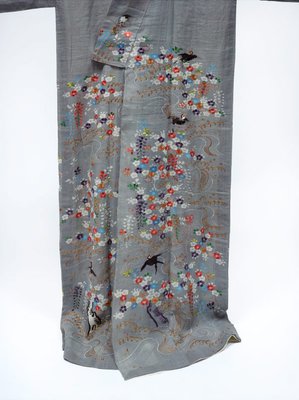
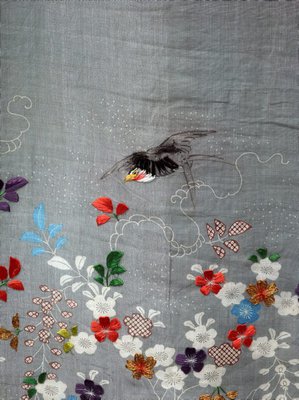
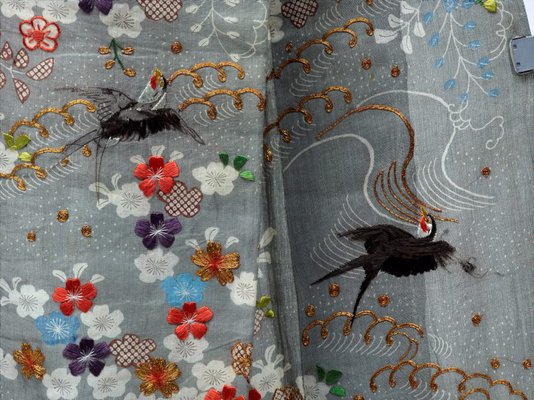
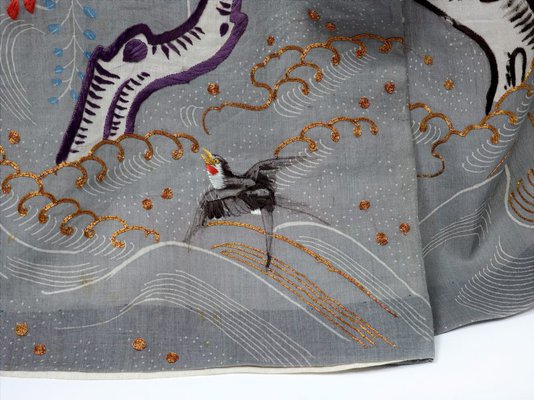


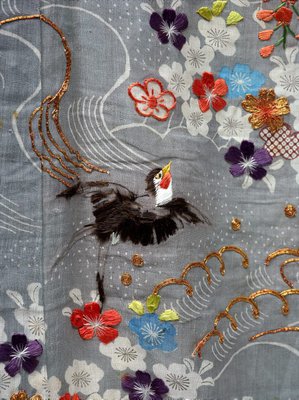

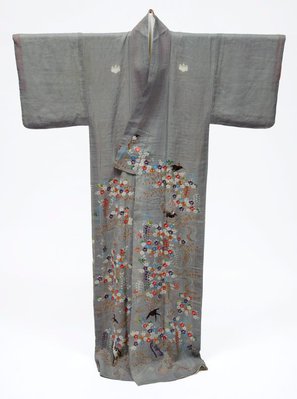
-
Details
- Other Title
- Katabira (light summer kimono) with design of swallows, wisteria and cherry blossoms on grey plain weave ramie ('asa')
- Place where the work was made
-
Japan
- Period
- Edo (Tokugawa) period 1615 - 1868 → Japan
- Date
- 1750-1850
- Media category
- Textile
- Materials used
- plain weave ramie ('asa'), paste-resist dyeing ('yūzen'), stencilled imitation tie-dyeing ('kata kanoko') and silk and metallic thread embroidery
- Dimensions
- 171.0 x 124.0cm; sleeve: 99.0 x 32.5 cm
- Credit
- Purchased with funds provided by the Asian Art Collection Benefactors 2014
- Location
- Not on display
- Accession number
- 240.2014
- Copyright
- Share
-
-
About
'Katabira' are made of light fabrics such as silk or ramie ('asa') and typically worn in summer. In the Edo period, women of both the elite samurai and wealthy commoner classes wore 'katabira'. However, those with particular designs such as landscape with seasonal plants and animals and motifs inspired by classical literature or courtly culture, commonly known as 'goshodoki', or ‘imperial court style’ executed in sophisticated dyed techniques and embroidery are reserved exclusively for women of the elite samurai class, especially female attendants in shogunal and daimyo household.
A swarm of swallows frolicking amidst branches of cherry blossoms and wisteria forms the main design of this katabira. Typical for kosode fashion of the late 18th and 19th centuries, the design is located along the hem and front edges of the garment, ending at the lower end of the collar ('eri'). This design arrangement is known as 'tsuma-zome', or ‘skirt design’. The impression of a vibrant, colourful spring scenery is successfully achieved through the variety of techniques employed for the flowers and birds. While some flowers are embroidered with lustrous red, purple and green silk threads, others are executed in 'Yūzen-zome' (paste-resist dyed) or stencilled imitation tie-dye ('kanoko shibori'). Embroidery with twisted gold threads sets dramatic highlights and enhances the elegance and luxury of this 'katabira'. The shoulder part is decorated with wisteria crests ('kirimon') that are reserved in white. Parts of the black embroidery used to define the swallows and tree trunks are missing. This is due to the iron mordant which was employed for black dyes but weakens and disintegrates the fibre with time.
REFERENCES:
Gluckman, Dale Carolyn & Takeda, Sharon Sadako. 'When art became fashion : kosode in Edo-period Japan'. With contributions by Monica Bethe, Hollis Goodall-Cristante, William B. Hauser, Kirihata Ken, Maruyama Nobuhiko, Nagasaki Iwao, Robert T. Singer. New York/Tokyo: Weatherhill and Los Angeles County Museum of Art, 1992Stinchecum, Amanda Myer. 'Kosode, 16th-19th century textiles from the Nomura Collection'. With essays by Monica Bethe and Margot Paul ; edited by Naomi Noble Richard and Margot Paul, New York: Japan Society and Kodansha International, 1984.
Asian Art Department, AGNSW, 2014.
-
Places
Where the work was made
Japan
-
Exhibition history
Shown in 1 exhibition
Glorious, Art Gallery of New South Wales, Sydney, 27 May 2017–06 Jan 2019
